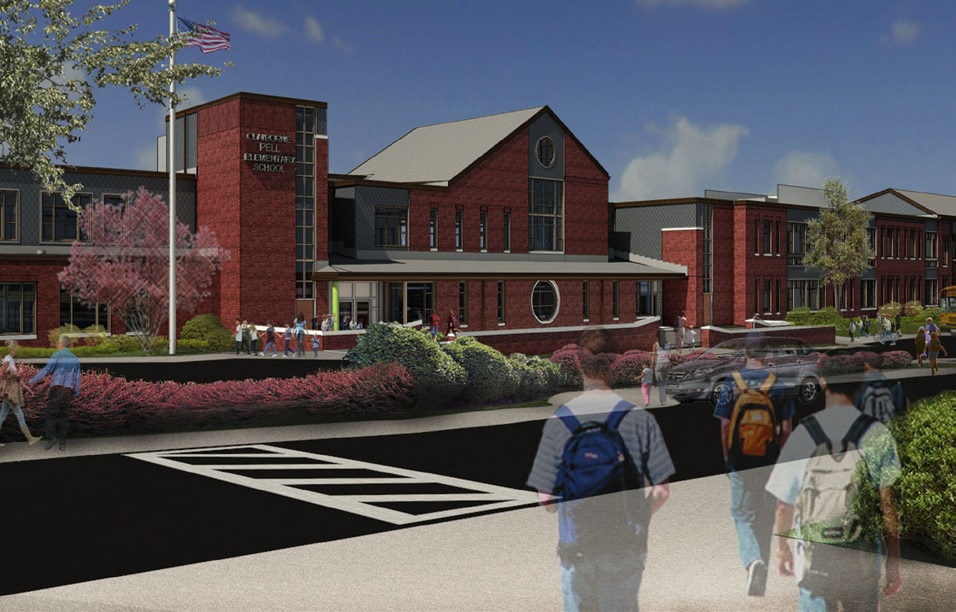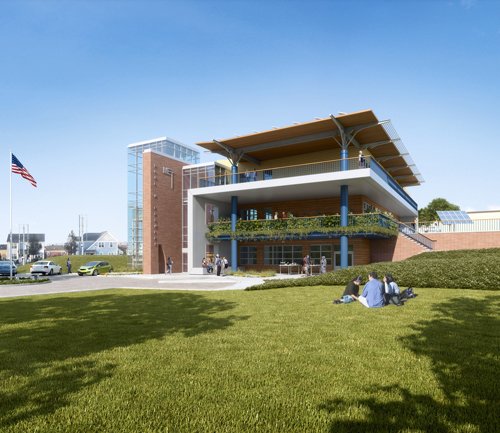By Carolyn Goldthwaite | Tue, January 21, 14
When you think back to your days spent in school what do you remember?
Was it a favorite teacher? The countless trips to the vending machine between classes? A visceral rush of excitement after your crush unexpectedly sat next to you in biology? I recently asked a colleague to recount her high school experience and received a surprising answer in return.
“My school was like a prison!”
 Not because it was strict but because the architect who designed it also happened to design prisons.
Schools and prisons, go figure...
The school was dark with little natural light, had the ventilation of a prehistoric cave, the ceiling tiles were covered with stains and often had overlooked, unusual growths – the list went on. If a student compares school to prison, that comparison should reflect the student’s displeasure for getting out of a cozy bed rather than the design of the school itself.
How we build and maintain our schools matter. The health and sustainability considerations within infrastructure, architecture, and design have lasting effects on students long after they walk across the graduation stage. Educational facilities should function as learning opportunities for students by exemplifying the latest and most effective building practices.
Not because it was strict but because the architect who designed it also happened to design prisons.
Schools and prisons, go figure...
The school was dark with little natural light, had the ventilation of a prehistoric cave, the ceiling tiles were covered with stains and often had overlooked, unusual growths – the list went on. If a student compares school to prison, that comparison should reflect the student’s displeasure for getting out of a cozy bed rather than the design of the school itself.
How we build and maintain our schools matter. The health and sustainability considerations within infrastructure, architecture, and design have lasting effects on students long after they walk across the graduation stage. Educational facilities should function as learning opportunities for students by exemplifying the latest and most effective building practices.
 Claiborne Pell Elementary School, Newport RI
We have an opportunity to build schools so they operate in a more sustainable manner and thankfully, many schools today are being built this way - from grisly structures to sleek facilities designed to stimulate learning and growth. They allow for natural daylight to flood in, have superior indoor air quality and integrate the building systems into the curriculum making the school a teaching tool for both students and the community.
Over the past few years I have had the opportunity to visit several schools that have been designed and built according to the Northeast Collaborative for High Performance Schools (NE-CHPS ) criteria. This criterion produces exemplary schools like the East Bay Met School and the Pell Elementary both in Newport, R.I.
Claiborne Pell Elementary School, Newport RI
We have an opportunity to build schools so they operate in a more sustainable manner and thankfully, many schools today are being built this way - from grisly structures to sleek facilities designed to stimulate learning and growth. They allow for natural daylight to flood in, have superior indoor air quality and integrate the building systems into the curriculum making the school a teaching tool for both students and the community.
Over the past few years I have had the opportunity to visit several schools that have been designed and built according to the Northeast Collaborative for High Performance Schools (NE-CHPS ) criteria. This criterion produces exemplary schools like the East Bay Met School and the Pell Elementary both in Newport, R.I.
 East Bay MET School, Newport RI
NE- CHPS is a set of prominent building and design standards for all schools from the cubbies of pre-K to the study halls of community colleges. CHPS fosters the development of schools that employ the latest energy efficiency measures, promote environmental synchronicity, and bolster the health of the students and faculty. The CHPS criterion has been tailored specifically for state code requirements, the Northeast climate, and regional environmental priorities.
NE-CHPS Paving the Way for School of the Future
In 2006 NEEP purchased a license from CHPS to create, with input from regional stakeholders, the NE-CHPS (Northeast) criteria. Since then over 37 schools have been built or renovated. Using the lessons learned from these school and best practices from across the country, including the CHPS Core Criteria , NEEP’s regional leadership group comprised of state agencies, utility program administrators, health advocates, facilities managers, architects and engineers have been working to update NE-CHPS to version 3.0. The criteria, which is now out for public review, includes:
East Bay MET School, Newport RI
NE- CHPS is a set of prominent building and design standards for all schools from the cubbies of pre-K to the study halls of community colleges. CHPS fosters the development of schools that employ the latest energy efficiency measures, promote environmental synchronicity, and bolster the health of the students and faculty. The CHPS criterion has been tailored specifically for state code requirements, the Northeast climate, and regional environmental priorities.
NE-CHPS Paving the Way for School of the Future
In 2006 NEEP purchased a license from CHPS to create, with input from regional stakeholders, the NE-CHPS (Northeast) criteria. Since then over 37 schools have been built or renovated. Using the lessons learned from these school and best practices from across the country, including the CHPS Core Criteria , NEEP’s regional leadership group comprised of state agencies, utility program administrators, health advocates, facilities managers, architects and engineers have been working to update NE-CHPS to version 3.0. The criteria, which is now out for public review, includes:
 Not because it was strict but because the architect who designed it also happened to design prisons.
Schools and prisons, go figure...
The school was dark with little natural light, had the ventilation of a prehistoric cave, the ceiling tiles were covered with stains and often had overlooked, unusual growths – the list went on. If a student compares school to prison, that comparison should reflect the student’s displeasure for getting out of a cozy bed rather than the design of the school itself.
How we build and maintain our schools matter. The health and sustainability considerations within infrastructure, architecture, and design have lasting effects on students long after they walk across the graduation stage. Educational facilities should function as learning opportunities for students by exemplifying the latest and most effective building practices.
Not because it was strict but because the architect who designed it also happened to design prisons.
Schools and prisons, go figure...
The school was dark with little natural light, had the ventilation of a prehistoric cave, the ceiling tiles were covered with stains and often had overlooked, unusual growths – the list went on. If a student compares school to prison, that comparison should reflect the student’s displeasure for getting out of a cozy bed rather than the design of the school itself.
How we build and maintain our schools matter. The health and sustainability considerations within infrastructure, architecture, and design have lasting effects on students long after they walk across the graduation stage. Educational facilities should function as learning opportunities for students by exemplifying the latest and most effective building practices.
 Claiborne Pell Elementary School, Newport RI
Claiborne Pell Elementary School, Newport RI East Bay MET School, Newport RI
East Bay MET School, Newport RI- Greater Focus on Occupant Engagement
- Crime Prevention through Environmental Design
- Enhanced Commissioning of Building Systems
- District Level Commitment to Sustainability
- Benchmarking
- Improved Acoustics Requirements
- zEPI Scale Available as Energy Scale Reference
